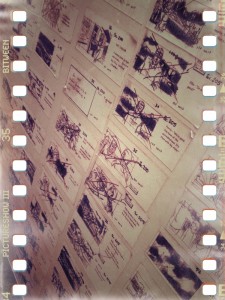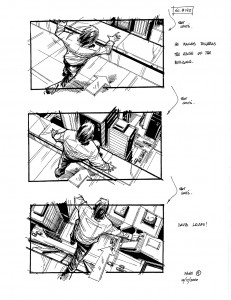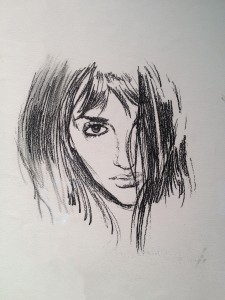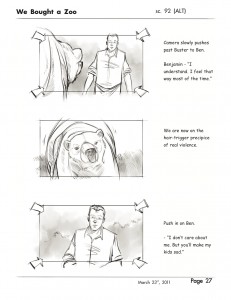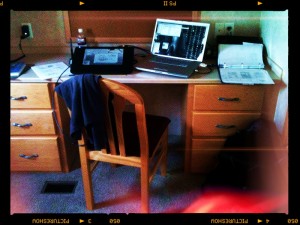Here’s Part 2 of our interview with Storyboard Artist Alex Hillkurtz. Enjoy!
What was your storyboard process like with Cameron working on Almost Famous.
It was really great. The first scene I drew for him was William and the band being lead on stage by the light of a flashlight. There’s some heavy symbolism there for me being lead out of the dark, and having a backstage pass to this amazing film. From there Cameron just wanted to keep going. I drew William and Penny Lane driving along Sunset to the Riot House, Russell getting electrocuted on stage, the bus crashing through the gates, some concert stuff, some bus stuff, some hotel room stuff… There was an amazing energy working on that film, it was like we were all on the road with a band we love. None of us wanted it to end.
Vanilla Sky seems like a natural film to require some extensive storyboarding. Did you just work on the ending or did you storyboard other sequences as well?
Again, there was quite a bit I drew for that film. The car crash, Times Square, the whole ending, etc… It was also the first time one of my drawings ended up on screen – the scene where Tom and Penelope draw each other, that’s my drawing of Penelope. Cameron had me do hundreds of sketches of her to catch the right mood. I think Cameron kept me on for a couple extra weeks just drawing pictures of Penelope Cruz. It’s a rough job.
Moving on to Elizabethtown, what was the biggest challenge for you working on that film?
It was actually a pretty great experience because Cameron and I had a lot of time to really dive in deep on that one. It’s a very personal story for Cameron and we really peeled back the layers of almost every scene to find the images that best expressed the story. For a while there I was splitting my time between LA and London (my wife was working on a film in the UK), so I’d be drawing these quintessential American scenes, listening to a playlist of only American bands, and then have this amazing cultural whip lash when I looked out the window to see black cabs on rainy London streets. Very surreal.
What sequence in We Bought A Zoo went through the most changes in regards to your work?
Cameron and I worked on the Buster Roams Free sequence for a while. It’s a pivotal moment for Ben in the film, and Cameron really wanted to show this connection between Ben and the bear. We kept adding little moments between the two of them, even writing in unspoken dialogue between these two characters yearning for connection and escape, like a conversation between two men both at a crossroads in their lives. The scene also required a lot of logistics of how to shoot Matt Damon and a real bear together – whether we needed to use VFX, stand-ins, animatronics etc. In the end I think it was a fairly straightforward shoot, with the emphasis on the moment of connection between two wise men.
You’ve now worked with Cameron on four feature films. Tell me about your working relationship with him and why it’s been so successful.
I think we trust each other to bring our best work. Cameron is a really intuitive writer, his scripts are a joy to read, and I love being in the room when we start turning his words into pictures. We’ll really unpack scenes to find out what they’re about at their core, and how best to express that visually. We’ll act things out, we’ll share clips from films we love, he has binders full of images culled from magazines that capture certain moments, emotions and gestures that we’ll incorporate into scenes. And he’s always scribbling down notes of ideas for dialogue or inspiration. You know the meeting is going well when Cameron is joyfully scribbling notes. And then there’s the music!
What is something about a storyboard artist that most people might not be aware of?
Movies can be such a visual feast, but they all start with a script, black and white words on a page. Storyboarding a scene is the first time a project is transformed from the written word into a visual medium. There’s something magical in that transition, it’s alchemy and I absolutely love it. A fellow storyboard artist has said that we’re the first ones to see the movie. That’s a cool thing!
You directed a film entitled Recipe for Disaster back in 2000. Was that a short film or a feature? Is it correct that humor writer Dave Barry wrote the script? Did that experience have an effect on your subsequent storyboard work? Do you hope to direct again in the future?
Yeah, that was a short film that my wife (before she and I met) had the script to. It’s based on a Dave Barry article that’s a spoof of disaster movies. It’s actually the project we met on, so thanks, Dave! I’ve made a few short films over the years, and you quickly learn that even if you can draw a sequence it doesn’t mean it’s shootable. Directing and storybaording feed off each other, so it’s a natural thing for me to go back and forth, figuring out new ways to stage action, interesting ways to portray an emotion. You can play on the page, try different things out, run the movie back and forth at no cost, it’s such an economical way to figure out your road map. Then when you go to shoot something, you’ve got a plan. You can always deviate from the plan, but it’s an amazing tool. And yes, I would love to direct again. I did second unit directing on It’s Complicated after boarding that film for Nancy Meyers, so the goal is to do more of that in the future.
You’ve worked with a wide variety of action and comedy directors in addition to Cameron (Jonathan Mostow, Simon West, Ivan Reitman, Peter Segal, Adam McKay, Nancy Meyers). In what ways are they different? How are they similar?
Some directors are very particular about what they want, so storyboarding becomes illustrating their vision. Others are very into collaboration. I really enjoy working with writer/directors, not only because I admire both those talents so much, but because they’ve lived with the story for a long time before anyone else gets involved. It becomes a matter of adding flesh to the bones, and discovering what sort of animal we’re all dealing with.
You’ve also recently worked with two directors who are more well-known as actors, both of whom are beginning their career as directors (Angelina Jolie and Ben Affleck). Any differences they might share, having come into directing with such strong acting backgrounds?
Angelina was great. Having come from in front of the camera, I think she’s really good with actors. There’s an immediate trust you have with other actors because you’ve been there and you understand the vulnerability. The unknown for her was in staging the action scenes, and again, translating the written word into interesting visuals, and that’s where I came in.
Argo is Ben’s third film as director, and it turns out he knows what he’s doing. Writing and directing is one thing, but acting and directing, I’m in awe of that! I don’t know how people do it. There are big crowd scenes in the film, as well as locations in other countries that needed to be married to sets in LA. I think early on Ben saw just how prepared he would be once filming began if he was armed with a stack of storyboards.
- Technology is radically changing the film industry these days, from visual effects to movie theatres to some films not having a single frame shot on actual film. How has technology changed the work you do on a daily basis?
I draw digitally using a Wacom cintiq tablet and Corel Painter. I lay out the dialogue and descriptions digitally, so I can email pdfs of entire scenes. Gone are the days of physically cutting and pasting paper, hand writing shot descriptions, whiting out my spelling mistakes… It’s a lot cleaner now. I’ll draw any given scene four of five times, there’s always changes with staging, or location, or whatever, so making changes digitally is fairly seamless. But with all this technology, it still has to feel hand-made and organic. I don’t want the fact that I’m drawing digitally to get in the way of the emotions of the scene.
I’ve been drawing 100% digitally since 2001. I was on a film in NY working with a director in LA, and it was insanely time consuming to fax everything at the end of every day. So I dove in and got myself a cintiq tablet and I’ve never looked back. The trick became how to find digital tools that mimic the physical tools (pens, pencils, and paper) that I’m used to, and Corel Painter does that beautifully.
What do you see as the primary role of the Storyboard Artist?
Ultimately storyboards are a communication tool. Ten people can read a script and have ten different ideas of what the movie will look like. Once there’s a drawing on a piece of paper, everyone can start rowing in the same direction. As a storyboard artist my job is to get the director’s vision out of their heads so others can see it. It takes a lot of conversation, a lot of thumbnail sketches, a lot of shared images, maybe a dash of mind reading.
Finally, if your career dreams came true, what would you be doing in ten years?
You know, I’ll always be drawing, and as long as directors are willing to have me, I’m there. But I’d also like to follow in the footsteps of some of my teachers and do the writing/directing thing. I’ve got stories to tell and it would be a shame if they never got off the page.
For more on Alex, check out his official site!


